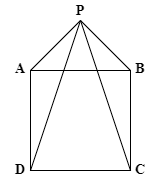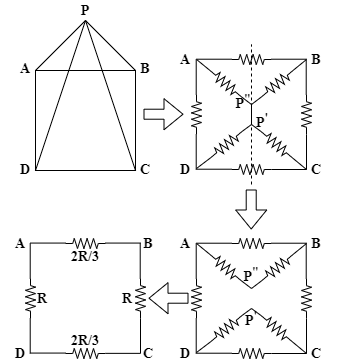
Find the equivalent resistance about any branch of the base of the square pyramid shown. Assume resistance of each branch is R.

A) $\dfrac{{7R}}{{15}}$
B) $\dfrac{{8R}}{{15}}$
C) $\dfrac{R}{2}$
D) ${\text{None of these}}$
Answer
219k+ views
Hint: This problem is completely based on simplifying the given circuit using logical reasoning like current direction and potential drop. Once simplified you need to see which connections are in series and which are in parallel. Then find the equivalent resistance accordingly.
Formulae used:
Equivalent resistance of n resistors connected in series connection is:
${R_{eq}} = {R_1} + \ldots + {R_i} + \ldots + {R_n}$.............(1)
Where,
${R_{eq}}$ denotes the equivalent resistance,
${R_i}$ denotes the resistance of the i number resistor.
Equivalent resistance of n resistors connected in parallel connection is:
$\dfrac{1}{{{R_{eq}}}} = \dfrac{1}{{{R_1}}} + \ldots + \dfrac{1}{{{R_i}}} + \ldots + \dfrac{1}{{{R_n}}}$................(2)
Where,
${R_{eq}}$ denotes the equivalent resistance,
${R_i}$ denotes the resistance of the i number resistor.
Complete step by step answer:

Given: Resistance of each branch is the same as R.
To find: The equivalent resistance for any base branch of the square pyramid. Here, we’ll try to find equivalent resistance across CD.
Step 1
This square pyramid can simply be viewed as a square with four resistors at four sides and the center (P) connected with each vertex by a resistor. The second diagram (top right in the picture) is just this same picture except that the point P is broken into two points \[P'\] and $P''$ which are connected by a resistance less wire.
Step 2
Now, notice in the top right diagram that as you try to find equivalent resistance across the CD side, the whole resistance setup is completely symmetric about the dashed line. Hence, voltage drop in both sides of the line will be exactly the same. So, everywhere on the line voltage will be exactly half of the total voltage dropped across the CD. Hence, \[P'\] and $P''$ have the same potential and no current will flow between them. Omitting the connection between \[P'\] and $P''$ you can draw the circuit as the third diagram (bottom left).
Step 3
Using eq.(2) equivalent resistance for two resistors connected in parallel can be written as:
$
\dfrac{1}{{{R_{eq}}}} = \dfrac{1}{{{R_1}}} + \dfrac{1}{{{R_2}}} \\
\Rightarrow \dfrac{1}{{{R_{eq}}}} = \dfrac{{{R_1} + {R_2}}}{{{R_1}{R_2}}} \\
\therefore {R_{eq}} = \dfrac{{{R_1}{R_2}}}{{{R_1} + {R_2}}} \\
$....................(3)
Now, just focus on the \[DP'C\] and $AP''B$ triangle parts of the circuit. In both cases 2 resistors are connected in series connection giving a resistance of 2R (using eq.(1)) and that 2R is in parallel with another R. So, using eq.(3) the equivalent resistance for this portion is:
\[{R'^{DP'C}}_{CD} = {R'^{AP''B}}_{AB} = \dfrac{{2R \times R}}{{2R + R}} = \dfrac{{2R}}{3}\]
Step 4
Finally, the equivalent circuit becomes the circuit shown in fourth diagram (bottom right) where \[{R'^{AP''B}}_{AB}\] is in series with two other resistors of resistance R . So, their equivalent resistance is:
$
{R'_{CD}}^{DABC} = {R'_{AB}}^{AP''B} + R + R = \dfrac{{2R}}{3} + 2R \\
\therefore {R'_{CD}}^{DABC} = \dfrac{{8R}}{3} \\
$
Step 5
Now, ${R’_{CD}}^{DABC}$ and \[{R'_{CD}}^{DP'C}\] are in parallel connection between CD. So, their equivalent resistance is:
$
R_{CD} = \dfrac{{R'_{CD}}^{DABC} \times {R'_{CD}}^{DP'C}}{{R'_{CD}}^{DABC} + {R'_{CD}}^{DP'C}} = \dfrac{{\dfrac{{8R}}{3} \times \dfrac{{2R}}{3}}}{{\dfrac{{8R}}{3} + \dfrac{{2R}}{3}}} = \dfrac{{16{R^2}}}{9} \times \dfrac{3}{{10R}} \\
\therefore {R_{CD}} = \dfrac{{8R}}{{15}} \\
$
Equivalent resistance about any branch is (B), $\dfrac{{8R}}{{15}}$.
Note: While simplifying the pyramid structure a student might get confused about where and how to break the circuit for simplification. Just follow current flow inside the circuit. Always remember that no current flows between two points having the same potential and you can cut that portion if no current flows through that part.
Formulae used:
Equivalent resistance of n resistors connected in series connection is:
${R_{eq}} = {R_1} + \ldots + {R_i} + \ldots + {R_n}$.............(1)
Where,
${R_{eq}}$ denotes the equivalent resistance,
${R_i}$ denotes the resistance of the i number resistor.
Equivalent resistance of n resistors connected in parallel connection is:
$\dfrac{1}{{{R_{eq}}}} = \dfrac{1}{{{R_1}}} + \ldots + \dfrac{1}{{{R_i}}} + \ldots + \dfrac{1}{{{R_n}}}$................(2)
Where,
${R_{eq}}$ denotes the equivalent resistance,
${R_i}$ denotes the resistance of the i number resistor.
Complete step by step answer:

Given: Resistance of each branch is the same as R.
To find: The equivalent resistance for any base branch of the square pyramid. Here, we’ll try to find equivalent resistance across CD.
Step 1
This square pyramid can simply be viewed as a square with four resistors at four sides and the center (P) connected with each vertex by a resistor. The second diagram (top right in the picture) is just this same picture except that the point P is broken into two points \[P'\] and $P''$ which are connected by a resistance less wire.
Step 2
Now, notice in the top right diagram that as you try to find equivalent resistance across the CD side, the whole resistance setup is completely symmetric about the dashed line. Hence, voltage drop in both sides of the line will be exactly the same. So, everywhere on the line voltage will be exactly half of the total voltage dropped across the CD. Hence, \[P'\] and $P''$ have the same potential and no current will flow between them. Omitting the connection between \[P'\] and $P''$ you can draw the circuit as the third diagram (bottom left).
Step 3
Using eq.(2) equivalent resistance for two resistors connected in parallel can be written as:
$
\dfrac{1}{{{R_{eq}}}} = \dfrac{1}{{{R_1}}} + \dfrac{1}{{{R_2}}} \\
\Rightarrow \dfrac{1}{{{R_{eq}}}} = \dfrac{{{R_1} + {R_2}}}{{{R_1}{R_2}}} \\
\therefore {R_{eq}} = \dfrac{{{R_1}{R_2}}}{{{R_1} + {R_2}}} \\
$....................(3)
Now, just focus on the \[DP'C\] and $AP''B$ triangle parts of the circuit. In both cases 2 resistors are connected in series connection giving a resistance of 2R (using eq.(1)) and that 2R is in parallel with another R. So, using eq.(3) the equivalent resistance for this portion is:
\[{R'^{DP'C}}_{CD} = {R'^{AP''B}}_{AB} = \dfrac{{2R \times R}}{{2R + R}} = \dfrac{{2R}}{3}\]
Step 4
Finally, the equivalent circuit becomes the circuit shown in fourth diagram (bottom right) where \[{R'^{AP''B}}_{AB}\] is in series with two other resistors of resistance R . So, their equivalent resistance is:
$
{R'_{CD}}^{DABC} = {R'_{AB}}^{AP''B} + R + R = \dfrac{{2R}}{3} + 2R \\
\therefore {R'_{CD}}^{DABC} = \dfrac{{8R}}{3} \\
$
Step 5
Now, ${R’_{CD}}^{DABC}$ and \[{R'_{CD}}^{DP'C}\] are in parallel connection between CD. So, their equivalent resistance is:
$
R_{CD} = \dfrac{{R'_{CD}}^{DABC} \times {R'_{CD}}^{DP'C}}{{R'_{CD}}^{DABC} + {R'_{CD}}^{DP'C}} = \dfrac{{\dfrac{{8R}}{3} \times \dfrac{{2R}}{3}}}{{\dfrac{{8R}}{3} + \dfrac{{2R}}{3}}} = \dfrac{{16{R^2}}}{9} \times \dfrac{3}{{10R}} \\
\therefore {R_{CD}} = \dfrac{{8R}}{{15}} \\
$
Equivalent resistance about any branch is (B), $\dfrac{{8R}}{{15}}$.
Note: While simplifying the pyramid structure a student might get confused about where and how to break the circuit for simplification. Just follow current flow inside the circuit. Always remember that no current flows between two points having the same potential and you can cut that portion if no current flows through that part.
Recently Updated Pages
A square frame of side 10 cm and a long straight wire class 12 physics JEE_Main

The work done in slowly moving an electron of charge class 12 physics JEE_Main

Two identical charged spheres suspended from a common class 12 physics JEE_Main

According to Bohrs theory the timeaveraged magnetic class 12 physics JEE_Main

ill in the blanks Pure tungsten has A Low resistivity class 12 physics JEE_Main

The value of the resistor RS needed in the DC voltage class 12 physics JEE_Main

Trending doubts
JEE Main 2026: Application Form Open, Exam Dates, Syllabus, Eligibility & Question Papers

Understanding Uniform Acceleration in Physics

Derivation of Equation of Trajectory Explained for Students

Hybridisation in Chemistry – Concept, Types & Applications

Understanding the Angle of Deviation in a Prism

Understanding Collisions: Types and Examples for Students

Other Pages
JEE Advanced Marks vs Ranks 2025: Understanding Category-wise Qualifying Marks and Previous Year Cut-offs

Understanding Atomic Structure for Beginners

How to Convert a Galvanometer into an Ammeter or Voltmeter

Understanding Centrifugal Force in Physics

JEE Main Marking Scheme 2026- Paper-Wise Marks Distribution and Negative Marking Details

Degree of Dissociation: Meaning, Formula, Calculation & Uses




